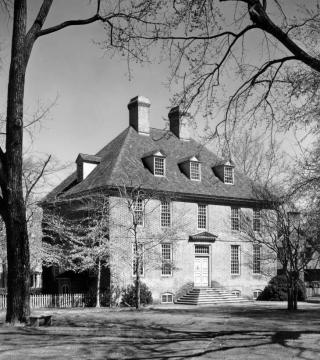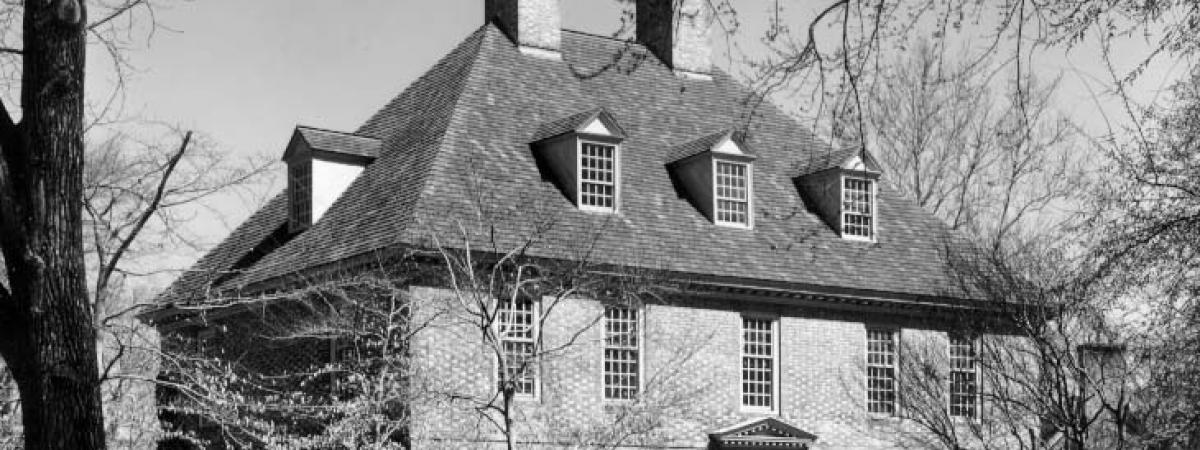
Constructed: 1732
Burned by French Troops: 1781
Renovations: 1848, 1867, 1905, 1919, 1922, 1931, 1971-72
Map it for me
The President's House was built in 1732 and has been the home of the presidents of William & Mary. It is the oldest college president's house in the United States. The President's House is located northeast of the Wren Building at 102 Richmond Road and faces the Brafferton.
Overview
In 1781, during the American Revolution, the President's House served as Cornwallis' headquarters. It accidentally burned while occupied by French troops before the Battle of Yorktown and was rebuilt with money from Louis XVI.
A memo reported in the William & Mary Quarterly notes that the dial post was placed in front of the house on April 15, 1815. The house's roof was damaged by a tornado in 1834. A porch was added i 1848-1849.
In 1862, during the Civil War, the house was used for various purposes including as Federal Headquarters for the area. Mrs. Virginia Southall and her family lived in the President's House from 1862-1864. After a raid by Confederate Colonel Mosby's men on Union troops in Williamsburg, defensive works were thrown up by the Federal troops across Old Campus in spring 1865 (see the Brafferton). The President's House was used in these works and some of its windows and doors were bricked up and loopholed. Total damage to the house during the war was $1600.
A wing added in 1867 made the house large enough to accommodate the professors. In 1879, there was a fire in the President's House. The roof was burned due to a defect in the chimney. A new, wider porch with 2 windows was added around 1905. The interior was remodeled in 1919, at which point the faculty wing may have been removed. In 1922 the center halls and the third floor were gutted by fire.
On January 15, 1931, the President's House was turned over to the Colonial Williamsburg Restoration Project headed by John D. Rockefeller, Jr., along with the Brafferton and the Wren Building, and all three were restored to their eighteenth-century appearance. The kitchen building was reconstructed for use as the President's study and library. The garage built by President Benjamin Ewell remained as a fire house. A new small, frame building was built near the kitchen for storing tools and fire apparatus.
A 1971-1972 renovation made the third floor habitable, added central air conditioning, and made the basement usable. The renovation also included the addition of a half bath on the first floor, new closets, and the replacement of the electrical and plumbing systems.
Material in the Special Collections Research Center
- University Archives Subject File Collection.
- Various university administrative office records.
- Flat Hat
Photographs
- "Buildings and Grounds--President's House," University Archives Photograph Collection, Special Collections Research Center, Earl Gregg Swem Library, The College of William & Mary.
- Iincluding circa l869-1874 (P1979.432), photo by D.H. Anderson, Richmond, Va. showing south porch with railing around top, wooden steps. Pickett fence around front of house. West wing.
- Pullen scrapbook, Acc. 1983.82/UA 5.076, has a photo of the faculty wing addition
- 1895--Catalog, p. 35
- 1899--Colonial Echo, p. 8
- 1901--Colonial Echo, p. 68
- 1903--Colonial Echo, p. 112
- 1905--Catalog, p. 12
- 1906--Colonial Echo, p.17
- 1906--Catalog, p.10 (new porch)
- 1907--Colonial Echo, p. 7
- 1908--Colonial Echo, p. 13
- 1910--Colonial Echo, p. 14
- 1922--Colonial Echo, p. 14
- 1924--Colonial Echo, p. 21
- 1926--Colonial Echo, p. 15, 16
- 1928--Colonial Echo, p. 19
- 1939--Colonial Echo, p. 19, 20
External Links

